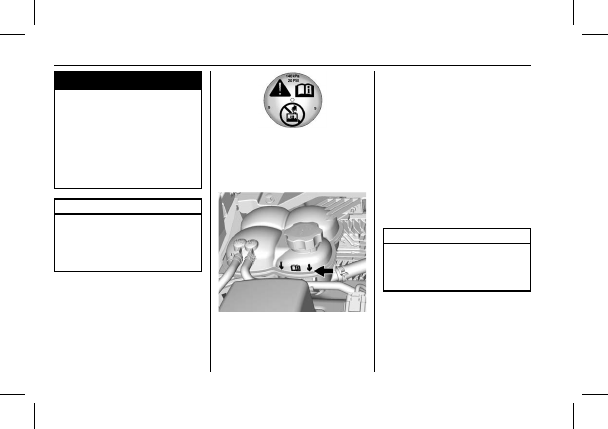
Engine Overheating; Vehicle Care- Page 249
2022 Chevrolet colorado Owner Manual
Table of Contents

Chevrolet Colorado Owner Manual (GMNA-Localizing-U.S./Canada/Mexico-
15274222) - 2022 - CRC - 3/12/21
248
Vehicle Care
{
Warning
Steam and scalding liquids from a hot
cooling system are under pressure.
Turning the pressure cap, even a little,
can cause them to come out at high
speed and you could be burned. Never
turn the cap when the cooling system,
including the pressure cap, is hot. Wait
for the cooling system and pressure cap
to cool.
Caution
Failure to follow the specific coolant fill
procedure could cause the engine to
overheat and could cause system
damage. If coolant is not visible in the
surge tank, contact your dealer.
The coolant surge tank pressure cap can be
removed when the cooling system, including
the surge tank pressure cap and upper
radiator hose, is no longer hot.
1. Turn the pressure cap slowly
counterclockwise. If a hiss is heard, wait
for that to stop. A hiss means there is
still some pressure left.
2. Keep turning the cap and remove it.
3. Fill the coolant surge tank with the
proper mixture to the mark pointed to
on the front of the coolant surge tank.
4. With the coolant surge tank cap off,
start the engine and let it run until the
upper radiator hose starts getting hot.
Watch out for the engine cooling fan. By
this time, the coolant level inside the
coolant surge tank may be lower. If the
level is lower, add more of the proper
mixture to the coolant surge tank until
the level reaches the mark pointed to on
the front of the coolant surge tank.
5. Replace the cap tightly.
6. Verify coolant level after the engine is
shut off and the coolant is cold.
If necessary, repeat coolant fill procedure
Steps 1
–
6.
Caution
If the pressure cap is not tightly installed,
coolant loss and engine damage may
occur. Be sure the cap is properly and
tightly secured.
Engine Overheating
The vehicle has an engine coolant
temperature gauge on the instrument
cluster to warn of engine overheating. See
Detailed Information for 2022 Chevrolet colorado Owner Manual
Lists of information found in 2022 Chevrolet colorado Owner Manual - Page 249
- 1. Turn the pressure cap slowly counterclockwise.
- 2. Keep turning the cap and remove it.
- 3. Fill the coolant surge tank with the proper mixture to the mark pointed to on the front of the coolant surge tank.
- 4. With the coolant surge tank cap off, start the engine and let it run until the upper radiator hose starts getting hot.
- 5. Replace the cap tightly.
- 6. Verify coolant level after the engine is shut off and the coolant is cold.
- 6. Caution If the pressure cap is not tightly installed, coolant loss and engine damage may occur.
